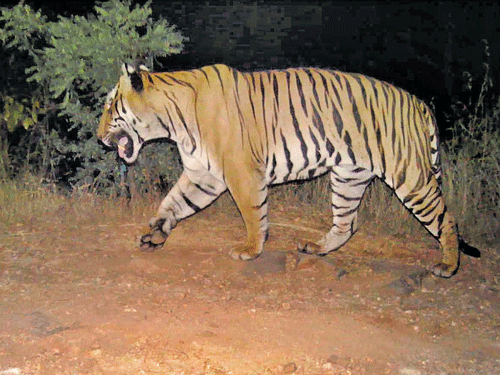
Male Mahadeshwara Wildlife Sanctuary and Cauvery Wildlife Sanctuary have the potential to be declared as tiger reserves, says a report by wildlife researchers released here on Tuesday.
The two sanctuaries house 14 tigers, 10 to 12 in MM Hills and two in Cauvery WS, says the report ‘Tigers of Male Mahadeshwara and Cauvery landscape - Report on tiger numbers in the dry forests in the confluence of Western and Eastern Ghats in Southern India’.
The report was prepared by wildlife scientist Sanjay Gubbi with four researchers from the Nature Conservation Foundation. During the five years (2011-15) of study, 809 camera trap locations were selected in both the sanctuaries. Each tiger has been identified and numbered.
Releasing the report, H S Mahadeva Prasad, the Chamarajanagar district incharge minister, said, “Unlike Kudremukh, there was no problem from locals in these areas. In the wake of the tiger population, a proposal will be sent to the State and central governments to declare them as tiger reserves.”
MM Hills - spread across 906 sq km - is popular for the temple it houses. The Cauvery WS, spread across 1,027 sq km, too is a popular destination, with River Cauvery and many tourist locations.
Gubbi said that it was the first time tiger and leopard density estimation was done using camera traps in the two areas.
They have high potential to double tiger population in the next five years. They are a part of Greater Biligiri Rangaswamy Temple (BRT) tiger landscape which includes BRT tiger reserve, Bannerghatta National Park, Satymangala tiger reserve and north Cauvery wildlife sanctuary in Tamil Nadu. The landscape can hold 150 tigers.
Individual tigers, common between BRT and MM Hills, were also documented highlighting that the Doddasampige-Yediyaralli corridor too should be protected. Currently, MM Hills-Cauvery have more tigers than some other tiger reserves in India like Namdapha tiger reserve in Arunachal Pradesh, Kawal in Telangana and Buxa tiger reserve in West Bengal, he said.
Reacting to the report, Principal Chief Conservator of Forests Vinay Luthra told Deccan Herald that these areas - like other forest areas in the State - were covered during the last tiger census which showed that the State has over 406 tigers.